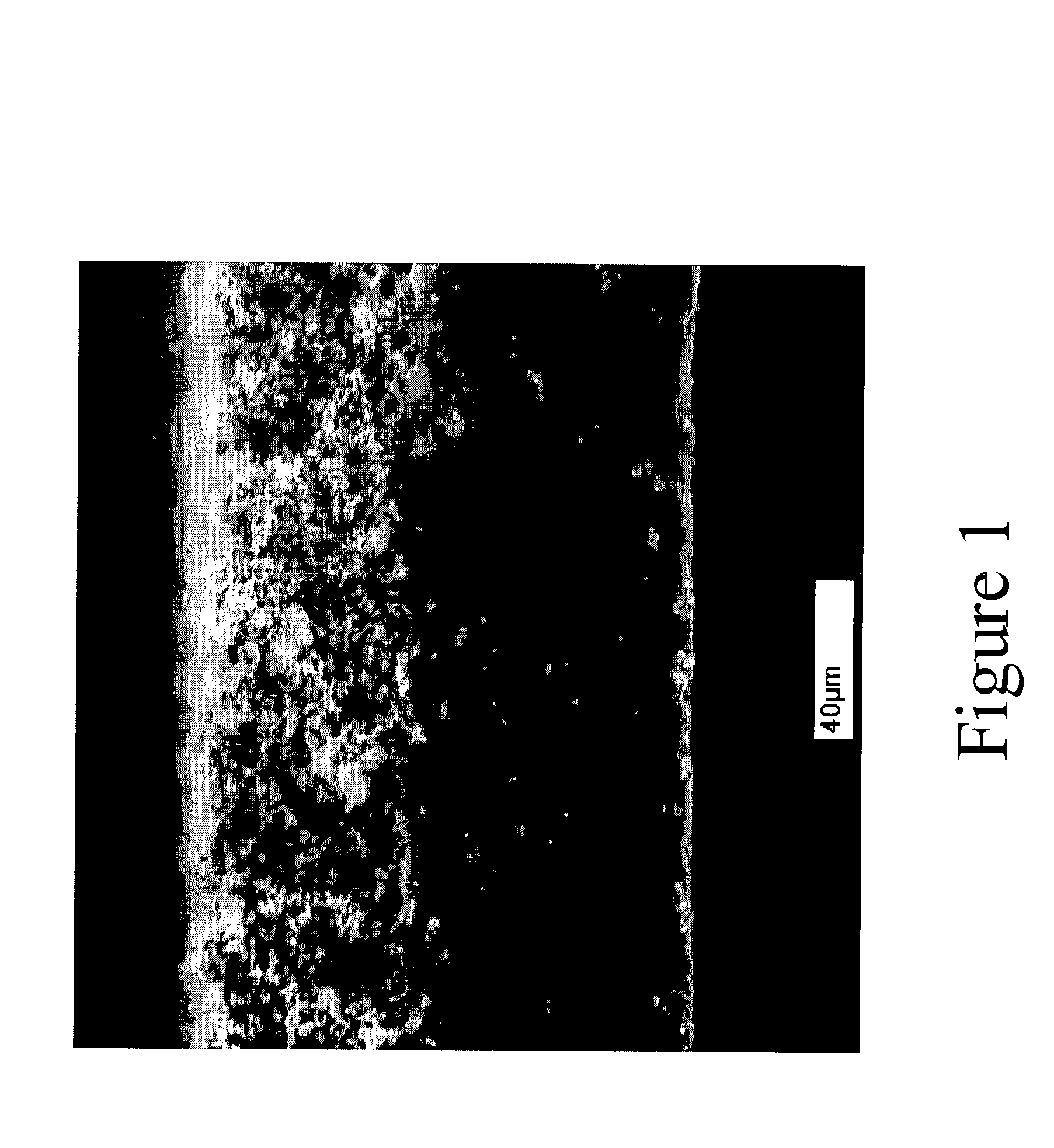Spatially-controlled modified porous membrane
- Summary
- Abstract
- Description
- Claims
- Application Information
AI Technical Summary
Benefits of technology
Problems solved by technology
Method used
Image
Examples
example 1
[0094]Hydrophilic 0.65 u Durapore (polyvinylidene fluoride microporous membrane, Millipore Corporation, Bedford, Mass.) is treated with a formulation consisting of 3.5% zonyl fluoroacrylate (i.e., 2-(N-ethylperfluorooctanesulfonamido)ethyl acrylate and analogs, available from Dupont Corporation, Wilmington, Del., under the tradename ZonylTAN), 0.5% hexanedioldiacrylate, and 0.1% Irgacure 621 (i.e., 2,2 dimethoxy-2-phenylacetophenone, available from Ciba Specialty Chemicals, Hawthorn, N.Y.) in decamethyltetrasiloxane. The membrane is placed on a sheet of polyethylene. No cover sheet is applied to the opposing facial surface. The membrane is transported through a Fusion Systems F600 (Rockville, Md.) UV unit at ten feet per minute with UV light exposure only directed toward the side covered by the polyethylene sheet. The uncovered side is not directly exposed and is in direct contact with the atmosphere that contains, among other things, oxygen and ozone. After emerging from the unit, ...
example 2
[0096]Hydrophilic 0.65 u Durapore (DVPP) is treated with a superphobic formulation consisting of 3.5% DuPont zonyl fluoroacrylate, 0.5% hexanedioldiacrylate, and 0.1% Irgacure 621 in decamethyltetrasiloxane. The membrane is placed on a sheet of polyethylene. A polyethylene cover sheet is applied that has open spaces corresponding to a pattern. This pattern can be in any shape. In this example the pattern is made by cutting out from the polyethylene sheet a lane about 2 mm in width ending in a circle about 5 mm in diameter. The membrane is transported through a Fusion systems UV unit at ten feet per minute with UV light exposure only directed toward the side covered by the unpatterned polyethylene sheet. The side covered by the patterned polyethylene sheet is not directly exposed and is in direct contact with the atmosphere that contains, among other things, oxygen and ozone. After emerging from the unit, the membrane is immediately placed in methanol to wash out unreacted species an...
example 3
[0098]In this example the depth of the hydrophobic layer or region is reduced by changing the concentration of the formulation ingredients. To make the hydrophobic region smaller, the active ingredients in the formulation are decreased in concentration. Hydrophilic 0.65 u Durapore (DVPP) is treated with a superphobic formulation consisting of 2% DuPont zonyl fluoroacrylate, 0.32% hexanedioldiacrylate, and 0.056% Irgacure 621 in decamethyltetrasiloxane. The membrane is placed on a sheet of polyethylene. No cover sheet is applied to the opposing facial surface. The membrane is transported through a Fusion systems UV unit at ten feet per minute with UV light exposure only directed toward the side covered by the polyethylene sheet. The uncovered side is not directly exposed and is in direct contact with the atmosphere that contains, among other things, oxygen and ozone. After emerging from the unit, the membrane is immediately placed in methanol to wash out unreacted species and other n...
PUM
| Property | Measurement | Unit |
|---|---|---|
| Fraction | aaaaa | aaaaa |
| Surface energy | aaaaa | aaaaa |
| Thickness | aaaaa | aaaaa |
Abstract
Description
Claims
Application Information
 Login to View More
Login to View More - R&D
- Intellectual Property
- Life Sciences
- Materials
- Tech Scout
- Unparalleled Data Quality
- Higher Quality Content
- 60% Fewer Hallucinations
Browse by: Latest US Patents, China's latest patents, Technical Efficacy Thesaurus, Application Domain, Technology Topic, Popular Technical Reports.
© 2025 PatSnap. All rights reserved.Legal|Privacy policy|Modern Slavery Act Transparency Statement|Sitemap|About US| Contact US: help@patsnap.com


